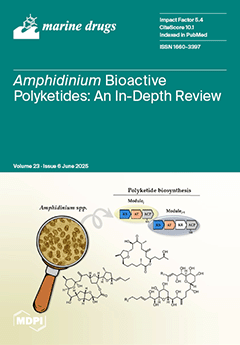Three new naphthalene–chroman dimer derivatives, daldinaphchromes A–C (
1–
3), two new chroman derivatives, daldichromes A (
5) and B (
6), along with five known compounds (
4,
7–
10) were isolated from the mangrove-derived
[...] Read more.
Three new naphthalene–chroman dimer derivatives, daldinaphchromes A–C (
1–
3), two new chroman derivatives, daldichromes A (
5) and B (
6), along with five known compounds (
4,
7–
10) were isolated from the mangrove-derived fungus
Daldinia eschscholzii HJX1P2. Their structures and stereochemistries were elucidated through detailed NMR and MS analyses, calculated electronic circular dichroism, and comparison with previously reported data. Compound
1 demonstrated inhibitory effects on nitric oxide (NO) production in LPS-induced RAW 264.7 cells, with an IC
50 value of 62.9 µM, and more effectively suppressed the expression of interleukin (IL)-6 than dexamethasone. A further mechanistic study suggested that
1 could prohibit the expression of iNOS in RAW 264.7 cells, and the molecular docking study suggested a possible interaction between
1 and the iNOS protein. Compounds
7 and
8 exhibited moderate to potent DPPH radical scavenging activity, with IC
50 values of 117.4 and 46.2 µM, respectively, compared with the positive control ascorbic acid (IC
50 = 45.6 µM). Compounds
4 and
10 showed ABTS
+ radical scavenging activity, with IC
50 values of 66.6 and 33.2 µM, respectively, which were equal to or lower than that of the positive control vitamin C (IC
50 = 59.7 µM). Compounds
1–
3,
7, and
9 showed antibacterial activity against three
Staphylococcus aureus strains, with MIC values of 74.4–390.6 μM.
Full article






